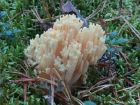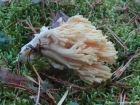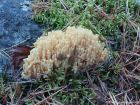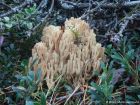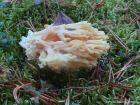Fruiting body medium-sized, slender, and often loosely clustered in large groups. The branches are upright, numerous, and densely packed. The colour is pale, greyish-white with a faint lilac-grey tint in young specimens, especially at the branch tips. As the fungus ages, it gradually takes on a more ochre-yellow hue due to the maturation of the spores. The flesh is white. Spore print pale yellow-brown.
Microscopic Features: The spores measure 10–12 x 4.5–6 μm and are elongated to ellipsoid, with distinct, relatively large, and elongated warts that tend to align in rows.
Similar species: The Ramaria genus comprises approximately 200 species of which many are so similar to each other that they can be distinguished only with a microscope.
Ramaria genus on Wikipedia.
Many mushrooms are poisonous, and some can be lethally toxic. Distinguishing between edible and poisonous mushrooms can be very challenging. Therefore, we strongly advise against consuming wild mushrooms. This website does not contain any information about the edibility or toxicity of mushrooms.
Although efforts have been made to ensure accuracy on this website, the information may contain errors and omissions. Therefore, all content provided is for educational and informational purposes only and should not be relied upon or used as a basis for consuming any plants or mushrooms.
External links are provided for reference only. We do not endorse or take responsibility for the content, advice, or products found on these sites or in any advertisements shown on this website.
